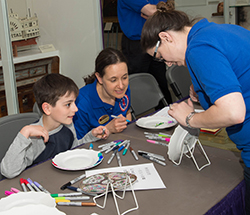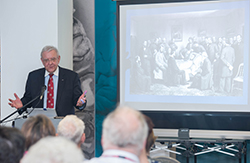Lincoln's final hours remembered at medical museum
By Paul Bello, National Museum of Health and Medicine
SILVER SPRING, Md. - The National Museum of Health and Medicine (NMHM) held a special open house tribute to Abraham Lincoln April 14th in commemoration of the 150th anniversary of his assassination. The event included guest speakers, activities for families and extended hours so guests could view NMHM's special Lincoln exhibit, which features artifacts related to his death, including the bullet that killed him.
Joining NMHM staff for the occasion was Lawrence C. Mohr, M.D., professor of medicine and director of the Environmental Biosciences Program at the Medical University of South Carolina. No stranger to the nation's capital, Mohr served as White House physician from 1987-1993.
According to Mohr, who has always been intrigued by Lincoln's time as president, the former Illinois lawyer turned politician became a war-time president not by choice, but by circumstance.
"The Civil War weighed heavy on Lincoln. More than 655,000 lives were lost between the North and the South," Mohr said. "He was physically and mentally exhausted when running for a second term. Though, he never waned from his focus of preserving the union and preventing slavery."
Following a decisive victory by the Union Army at the Battle of Antietam in Maryland, Mohr believes Lincoln now had the moral authority to issue his now famous Emancipation Proclamation, which proclaimed the freedom of slaves in the ten states that were still in rebellion. The hope was it would be just a matter of time before the South could be rebuilt, but that all changed as a result of his death.
"That bullet not only killed Lincoln, but it also killed any hope of reconstruction for the South. His death ushered in a period of segregation and continued bitterness," Mohr said. "I believe his assassination is the greatest tragedy this country has ever seen."
While Mohr provided insight into the aftermath following Lincoln's death, Thomas A. Gennarelli, M.D., clinical professor of neurosurgery at George Washington University, delved into the details of his injury.
The bullet that killed Lincoln was found to be two-thirds of the way into his brain. Based on notes taken from doctors aiding the injured president, Gennarelli said the bullet severed a major vein, which would explain the blood loss and severe blood clot beneath the dura (membrane covering the brain).
"After being shot, he had no pulse and no respiration. There was also high intracranial pressure, hemorrhaging and dislocation," Gennarelli said. "There really wasn't much anyone could do."
Given the fact that Lincoln was shot at close range, Gennarelli estimates him being struck with approximately 146 joules of pressure, which is the scientific term for measuring the energy something has. At that rate, he said the force caused severe pressure waves and a significant collapse of the cavity in Lincoln's brain.
"What an amazing program," said Forest Hamlin, a resident of Laurel, Md. "The speakers were fantastic and everything was really interesting. I certainly wasn't expecting such an overall presentation like this."
Cynthia Glazer, who attended the program with her eight year-old daughter Kayla, was equally impressed with NMHM's Lincoln exhibit and activities. The mother/daughter pair teamed up to make a presidential mourning badge, just as citizens did in 1865 to symbolize their grief upon hearing the news of Lincoln's death.
"It's a great way for kids to learn more about Lincoln," Glazer said. "I'm very impressed with how the information was presented. The museum made it a night for parents and children."
To learn more about NMHM programs, visit www.medicalmuseum.mil.

|
Caption:
Gwen Nelmes (right), tour program coordinator at the National Museum of Health and Medicine (NMHM), and volunteer docent Monica Monteon (center), help a young guest with an arts and crafts project at NMHM on the 150th anniversary of the assassination of President Abraham Lincoln in 1865. (Disclosure: This image has been cropped to emphasize the subject.) (National Museum of Health and Medicine photo by Matthew Breitbart / Released) |

|
Caption:
Lawrence C. Mohr, M.D., professor of medicine, Medical University of South Carolina, speaks at the National Museum of Health and Medicine (NMHM) on April 14, 2015, the 150th anniversary of the assassination of President Abraham Lincoln in 1865. (Disclosure: This image has been cropped to emphasize the subject.) (National Museum of Health and Medicine photo by Matthew Breitbart / Released) |

|
Caption:
Thomas A. Gennarelli, MD, clinical professor of neurosurgery at George Washington University, speaks at the National Museum of Health and Medicine (NMHM) on April 14, 2015, the 150th anniversary of the assassination of President Abraham Lincoln in 1865. (Disclosure: This image has been cropped to emphasize the subject.) (National Museum of Health and Medicine photo by Matthew Breitbart / Released) |

|
Caption:
Thomas A. Gennarelli (left), M.D., clinical professor of neurosurgery at George Washington University, and Lawrence C. Mohr, M.D. (right), Professor of Medicine, Medical University of South Carolina, review where President Abraham Lincoln was shot, during a talk at the National Museum of Health and Medicine, on the 150th anniversary of the assassination of President Abraham Lincoln in 1865. (Disclosure: This image has been cropped to emphasize the subject.) (National Museum of Health and Medicine photo by Matthew Breitbart / Released) |



